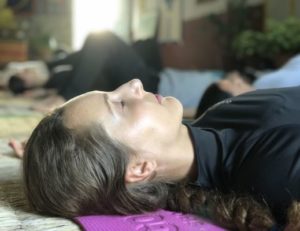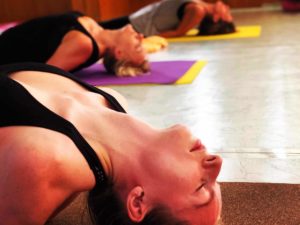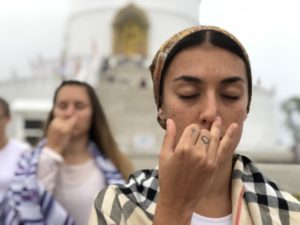Diaphragmatic breathing is natural breathing. Only taking about 10 natural breaths brings our awareness to where your breath is flowing. No pushing or changing. Just bringing our awareness to it helps relief from stress and depression. This will automatically slow our breath down and further bring awareness to the breathing practice. Breathing with awareness stimulates the whole nervous system through Prana flow and improves the brain functions. It quiets the mind and brings us to the present moment.
Diaphragmatic breathing is good for rheumatism, arthritis, high blood pressure, any addictive disorder, digestive problems and mental disturbances of any kind. It is useful for removing energy blockages in the joints and therefore results in a freer flow of energy throughout the body. It helps improve self-awareness and self-confidence. The reason we teach these exercises is because most people have lost the natural ability to breathe healthily. Working in an office and being stagnated in one position the whole day, constricts the flow of the air and being confronted with stressful situations tenses up the abdominal muscles and restrains the diaphragm from working normally. People get stuck on a sympathicus activation which affects their well-being in their lives both at work, as well as outside of work. So how to get back our natural and healthy Diaphragmatic breathing?
Step by step guidance in Makarasana (Crocodile Position)
Establish Diaphragmatic Breathing
One should learn to breathe correctly. To learn to relax by using the correct way of breathing, you start by lying down on your stomach, then cross your arms over the head, and rest your forehead on the lower arms. Let the arms be closer to your body so that your upper body is a little up and your head can hang down relaxed and your neck is straight.
Keep your legs apart, heels facing inward, toes outward, the inner rim of your feet touching the ground.
Bring your awareness to the place where you are right now. Be aware of your whole body-space and relax your body from head to toe. Gently become aware of the flow of your breath and let it flow freely. Allow the breath to flow through your whole body.
Focus on your stomach and navel area and start breathing more deeply against the ground. Feel how your body is lifted up as you inhale and slowly moving down as you exhale. Try to keep your breath even and slow, let there be no pauses in your breath, neither between breathing in and breathing out nor between breathing out and breathing in. Make sure you do not engage your abdominal muscles in the exercise, let the movement only come from your diaphragm, your main breathing muscle.
Feel how your abdominal organs get squeezed as your diaphragm contracts and move down with inhalation. Observe that you exhale consciously and with full awareness and let your diaphragm relax bit by bit and release the pressure on your abdominal organs.
Increase the movement of your diaphragm with every breath that you take and allow your breath to slow down and deepen more and more.
Lie down in shavasana (Corpse Position)
Now, very slowly, turn over to your left side and roll over onto your back and lie down in Shavasana. Arms alongside the body, a bit apart from the body, resting on the floor with the palms up. Bring your feet comfortably apart and relax completely, let your toes drop towards the sides. Breathe in the same manner as you were breathing before. Feel the gentle rise and fall of your abdomen. Observe the slow contraction and relaxation of your main breathing muscle.
Place your right palm just above the navel centre and your left palm on your chest, arms relaxed on the sides of the body. Keep breathing slowly and smoothly. Observe the movement of your right palm. You can feel that the left palm is not moving as your breath is flowing freely and deeply.
Breathing Q & A
Question – I have been practicing diaphragmatic breathing for half a year now and there are still three problems I cannot solve. When I breathe deeply in Macarasana, the second half of the inhale is jerky, while the exhale or the breathing in Shavasana is very smooth. And also my arms become numb after some time in Macarasana, no matter how I place them (there are not so many options and sometimes my lower back starts hurting until I release the arms. The closer I place the elbows to the chest, the better the numb arms and the worse the lower back. Is there anything I can do?
Answer – The jerks are normal when the diaphragm is not so strong yet and we breathe in fully. It´s the muscle shaking. If it´s not the muscle itself then it comes from the upper vertebrae and the nerves from the neck. This is where the numbness in the arms also comes from. From the upper thoracic vertebrae that connect with the neck. The whole shoulder belt is involved. You can do more shoulder opening and the evil hand on the wall exercise to release more. As the lower back starts hurting more with the elbows closer to the body it seems to be an over lordosis that you react to. Then more spinal asanas are good to stabilize the spine and bring more space between the spinal discs.
If you only want to work on the breath and the back pain is disturbing you can find other positions for your arms also. As long as you can breathe against the ground your diaphragm will be trained.



